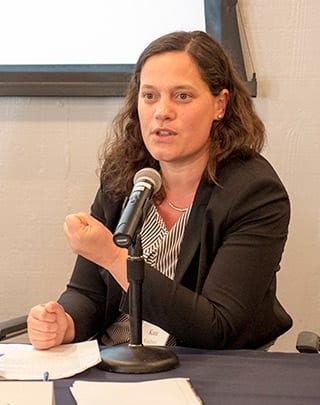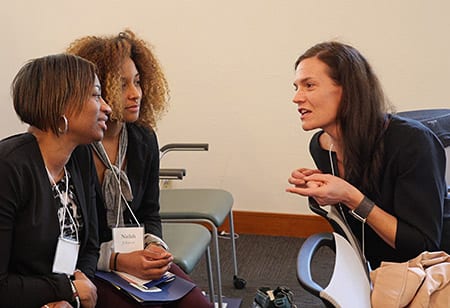By Andrew Cohen

Public interest lawyers and social justice advocates are often urged to be pragmatic—to accept certain compromises in order to achieve small victories. Berkeley Law’s national convening on the devastating impact of juvenile fines and fees, however, sounded a different refrain.
“These fees cause tremendous harm to vulnerable families who can least afford to pay them,” said Stephanie Campos-Bui ’14, supervising attorney at the school’s Policy Advocacy Clinic (PAC). “They’re harmful, unlawful, and costly—both to the people charged and to the counties trying to collect. This gathering signals the mobilization of a national effort to end this practice nationwide, to help improve youth rehabilitation and stabilize families.”
The convening, co-organized with Juvenile Law Center of Philadelphia, brought together lawyers, researchers, and advocates from across the country to share best practices and discuss strategies for achieving broad reform. They explored the three main buckets of juvenile justice debt—fines, fees, and restitution—and their disproportionate impact on low-income families of color, draining limited resources for them to spend on vital needs like housing and transportation.
The clinic has become a national catalyst on the issue after producing reports about how these regressive fees, often charged illegally, impose hardship on families while generating little or no financial gain.
Exhaustive research by PAC students revealed that California counties charged families for detention in juvenile hall, legal counsel, electronic ankle monitoring, probation supervision, drug testing, and investigation reports. Many families could not afford to pay the fees, resulting in debt that became a permanent legal judgment—leading to wage garnishment, bank account levies, and tax intercepts.
Alameda County’s fees for an average youth in the juvenile system jumped more than 10-fold between 2009 and 2016, yet collection-related costs meant the county saw no meaningful budget gain from this staggering increase. The clinic’s findings prompted Alameda County and several other California counties to ban such fees.
That research also paved the way for Senate Bill 190, signed in October, which repealed them statewide. Tens of thousands of low-income families have already been relieved of more than $70 million in previously assessed fees, with more to come as counties end their collection practices.
PAC is working with families, advocates, and counties to ensure that the bill is being implemented throughout California. This spring, the clinic will join groups across the country to launch a #DebtFreeJustice campaign and website that will serve as a resource hub for the national push to eliminate juvenile fines and fees.

“PAC’s research showed how this was causing high pain to vulnerable families with low financial gain to counties,” said Kate Weisburd, who directs the East Bay Community Law Center’s Youth Defender Clinic. “It took years of filing Public Records Act requests for the clinic to collect the data to make that happen, and to make this movement possible.”
Jarring racial inequities
Berkeley Law graduate Laura John Ridolfi ’05, policy director for the W. Haywood Burns Institute for Justice Fairness & Equity, presented data about severe racial disparities within the juvenile system. According to 2016 figures from the California Department of Justice, Black youth in California are 4.4 times more likely to be arrested than White youth.
Black youth are also 7.6 times more likely to be detained, 3.3 times more likely to receive probation, 4.4 times more likely to be removed from their family’s home, and 5.9 times more likely to be moved to adult court. Moreover, criminologists have found that juvenile debt correlates with higher recidivism.
“We’re seeing great progress when it comes to shutting down youth prisons and lowering incarceration rates in some areas, and major reforms that were previously thought unthinkable,” Ridolfi said. “But we still have real work to do when it comes to racial disparities.”
Panelists emphasized race’s importance in the proliferation of these fees—and urged colleagues to not shy away from that narrative in pushing to abolish them nationwide.
“Mass incarceration racial disparities are profound,” said Lisa Foster, co-director of the Fines and Fees Justice Center, who described how private probation collection companies have wide latitude to profit from those charged. “If we pretend these disparities aren’t there, we’re not going to solve this problem.”
According to Jess Bartholow of the Western Center on Law and Poverty, “Stereotypes about poor parents of color were driving this policy, that they don’t care for these kids and need to be held accountable. Even if a parent isn’t engaged, a fee isn’t going to change that. In fact, these fees achieve the opposite—they create guilt, strife, and conflict in the home.”
Temple University law professor Colleen Shanahan noted how Pennsylvania can collect child support from parents to take care of their youth in juvenile detention. She said parents routinely received incomprehensible bills and have wages garnished with no notice, and that Philadelphia paid an attorney $310,000 a year to collect juvenile fees—plus incentives based on how much he collected—until a clinic report and media coverage prompted the city to terminate his position.

“One dad, Boris, had a judge ask him which juvenile facility he wanted his son removed to,” Shanahan recalled. “Boris said, ‘If I choose a better facility that costs more, he’ll be treated better but that will take money away from my other kids.’ Can you imagine putting a parent in that type of position?”
Setting strategy
Researchers described data gaps and tactics for how to collect, interpret, and deploy figures on the assessment and collection of juvenile fees. They also discussed effective models for community organizing, individual representation impact litigation, policy advocacy, and communication.
“We have to unpack all the ways our legal system is unjust to kids of color,” Weisburd said. “It’s not just that more of them are arrested, but that it gets worse for them with each step deeper into the juvenile system.”
Panelists stressed the need to publicize individual stories about the destabilizing and counterproductive impact of juvenile fees. As noted in one PAC report, Los Angeles County billed Sally Stokes more than $1,000 for her granddaughter’s detention and spent nearly $13,000 pursuing the debt from a grandmother living on Social Security benefits—more than 10 times the debt itself.
Conference participants called for involving affected communities throughout each stage of policy reform efforts, and for connecting juvenile fees to related issues facing economically disadvantaged people of color.
“It’s important to keep these youth and their families at the heart of any planning, messaging, and advocating,” Campos-Bui said. “We need adequate resources for on-the-ground organizations that help families deal with a range of challenges associated with juvenile system involvement. A top-down approach won’t be successful because local practices are so varied.”